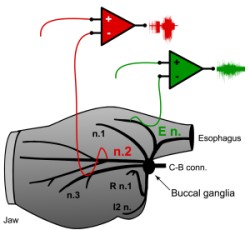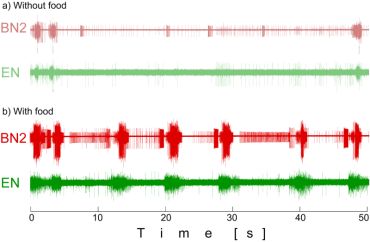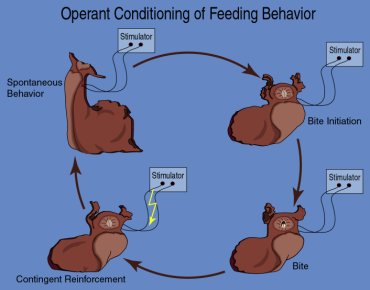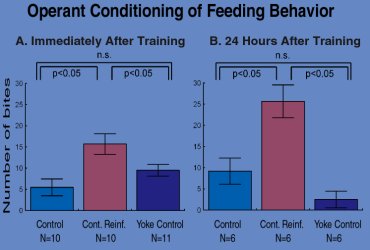|
Operant
conditioning in Aplysia
For operant conditioning one needs a spontaneous behavior that can be modified by reinforcement. About the only thing Aplysia does in its natural environment is to eat and reproduce. Naturally, their feeding behavior has received some attention from neurobiologists interested in operant conditioning (see videos of the Aplysia biting behaviour). From this research it was known that the esophageal nerve (En) had something to do with reinforcement. It is believed that sensory receptors in the buccal cavity transmit gustatory stimuli to the buccal ganglion via this nerve. We performed in vivo recordings from the anterior branch of En in feeding Aplysia via surgically implanted electrodes. These studies revealed presumably afferent activity (30Hz/3s) that coincided with biting and swallowing. In these experiments, I recorded simultaneously from the buccal nerve 2 (BN2) to determine the temporal relationship between the firing of the esophageal nerve (Figure below: EN) and the feeding behaviour. Activity in the esophageal nerve during spontaneous bites without any food present (a) is smaller and shorter than esophageal nerve activity when the animal is swallowing food (b). This constitutes the basis for using esophageal nerve stimulation (mimicking food presence) as reinforcement in an operant conditioning paradigm. In this paradigm, we substituted food reinforcement (unconditioned stimulus, US) with extracellular stimulation of the anterior branch of the esophageal nerve via the same surgically implanted electrodes that were used for the recordings. The pattern of stimulation was modelled after those recordings from feeding Aplysia (30Hz/3s). In other words, the stimulation of the animals nervous system tried to convey the message that food was being ingested. This is reminiscent of a scene in the movie "The Matrix", where Cypher is having dinner with agent Smith and says: "I know this Steak doesn't exist. I know that when I put it in my mouth, the Matrix is telling my brain that it is juicy and delicious." See the scene in the following formats: MPEG hi (7MB), MPEG lo (1.5MB), QuickTime (5.5MB), Real (800K). In an experimental group, nerve stimulation was made contingent on spontaneous biting behaviour. In other words, the animals could stimulate themselves by biting. In a yoked control group, the animals received the same pattern and amount of stimulation as the animals in the experimental group, but independent of their behaviour. A third group did not receive any stimulation at all (no-US control group). Training lasted for 10 minutes. The animals were then tested for spontaneous biting behaviour either immediately after training (A) or 24 hours later (B). Each test session lasted 5 minutes. At both time points, contingent reinforcement lead to a significantly higher rate of biting in the experimental group compared to both controls. These results show that contingent in vivo stimulation of the anterior branch of the esophageal nerve in Aplysia is sufficient to induce an operant memory that lasts for at least 24 hours. I have more about that experiment on this poster. So much for the development of a self stimulation procedure in Aplysia using virtual stimuli as reinforcers to operantly condition feeding behavior. A closer look at what the neuronal mechanisms of this operant reward learning might be, can be read in our paper: Operant Reward Learning in Aplysia: Neuronal Correlates and Mechanisms. |



